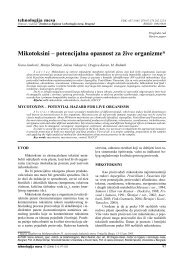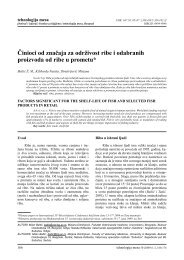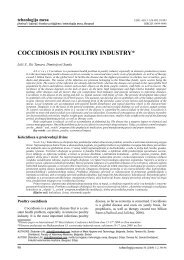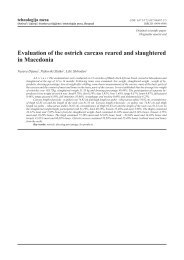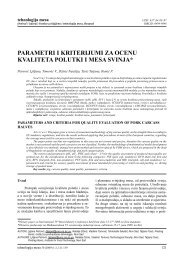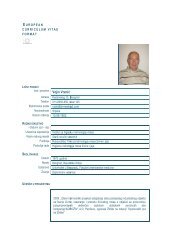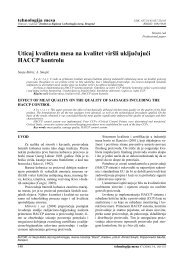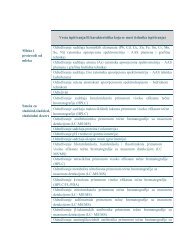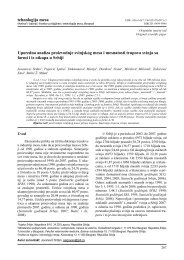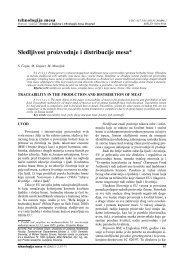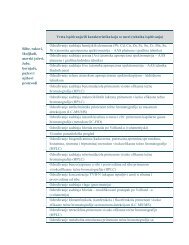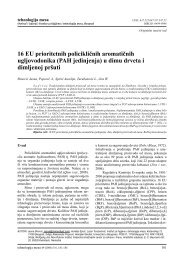Bakteriocini BMK kao prirodni protektori hrane - inmesbgd.com
Bakteriocini BMK kao prirodni protektori hrane - inmesbgd.com
Bakteriocini BMK kao prirodni protektori hrane - inmesbgd.com
You also want an ePaper? Increase the reach of your titles
YUMPU automatically turns print PDFs into web optimized ePapers that Google loves.
Tehnologija mesa 51 (2010) 1, 83–94Chen H., Hoover D. G., 2003. Bacteriocins and their FoodApplications. Comprehensive Reviews in Food Scienceand Food Safety, 2, 82–100.Cleveland J., Montville T. J., Nes I. F., Chikindas M. L.,2001. Bacteriocins: Safe, natural antimicrobials for foodpreservation. International Journal of Food Microbiology,71, 1–20.Davis D. B., Dulbecco R., Eisen N. H., Ginsberg S. H., 1990.Microbiology. 4 th ed. J. P. Lippuncott Company, E.Washington Square, Philadelphia. PA.Diep D. B., Havarstein L. S., Nes I. F., 1996. Characterizationof the locus responsible for the bacteriocin productionin Lactobacillus plantarum C11. Journal of Bacteriology,178, 4472–4483.Diep D. B., Nes I. F., 2002. Ribosomally synthesized antibacterialpeptides in Gram-positive bacteria. Current DrugTargets 3: 107-122.Dufour A., Rince A., Uguen P., LePennec J. P., 2000. IS1675,a novel lactococcal insertion element, forms a transposon-likestructure including the lacticin 481 lantibioticoperon. Journal of Bacteriology 182, 5600–5.Eijsink V. G. H., Skeie M., Middelhoven P. H., BrurbergM. B., Nes I. F., 1998. Comparative studies of class Iabacteriocins of lactic acid bacteria. Applied EnvironmentalMicrobiology, 64, 3275–81.Eijsink V. G. H., Axelsson L., Diep D. B., Havarstein L.S., Holo H., Nes I. F., 2002. Production of class IIbacteriocins by lactic acid bacteria; an example ofbiological warfare and <strong>com</strong>munication. Antonie vanLeeuwenhoek, 81, 639–654.Engelke G., Gutowski-Eckel Z., Hamelmann M., Entian K.D., 1992. Biosynthesis of the lantibiotic nisin: genomicorganization and membrane localization of the NisBprotein. Applied Environmental Microbiology, 58, 3730–3743.Ennahar S., Sashihara T., Sonomoto K., Ishizaki A., 2000.Class IIa bacteriocins: Biosynthesis, structure andactivity. FEMS Microbiology Review, 24, 85–106.Fox P. F., 1993. Cheese: an overvies. In: Fox, P.F. (Ed.), Cheese;Chemistry, Physics and Microbiology. Chapman & Hall,London, England, 1–36.Geisen R., Holzapfel W. H., 1996. Genetically modified starterand protective cultures. Food Microbiology, 30, 315–324.Gratia A., Fredericq P., 1946. C R Seanc Soc. Biol., 140:1032-1033, in Mayr-Harting and others, 1972.Hansen J. N., 1993. Antibiotics synthesized by post translationalmodification. Annual Review of Microbiology, 47,535–564.Hartnett D. J., Vaughan A., van Sinderen D., 2002.Antimicrobial-Producing Lactic Acid Bacteria Isolatedfrom Raw Barley and Sorghum. Journal of the Instituteof Brewing, Vol. 108, 2, 169–177.Hastings J. W., Sailer M., Johnson K., Roy K. L., VederasJ. C., Stiles M. E., 1991. Characterization of leucocinA-UAL 187 and cloning of the bacteriocin gene fromLeuconostoc gelidum. Journal of Bacteriology, 173,7491–500.Henderson J. T., Chopko A. L., van Wassenaar P. D., 1992.Purification and primary structure of pediocin PA-1produced by Pediococcus acidilactici PAC-1.0. Archivesof Biochemistry and Biophysics, 295, 5–12.Holzapfel W., Geisen R., Schillinger U., 1995. Biologicalpreservation of foods with reference to protective cultures,bacteriocins and food-grade enzymes. InternationalJournal of Food Microbiology, 24, 343–362.Hugas, M., 1997. Biopreservation of meat and meat products.Actes du collague lactic, Caen, France, 213–227.Hurst A., 1981. Nisin. Adv. Appl. Microbiol., 27, 85–123.Jacob F., Lwoff A., Siminovitch L., Wallman E., 1953.Definition de quelques termes relatifs a la Pysogenie.Ann Inst. Pasteur Paris, 84, 222–4.Joerger M. C., Klaenhammer T. R., 1986. Characterizationand purification of helveticin J and evidence for achromosomally determined bacteriocin produced byLactobacillus helveticus 481. Journal of Bacteriology,167, 439–46.Klaenhammer T. R., 1993. Genetics of bacteriocins producedby lactic acid bacteria, FEMS Microbiology Review, 12,39–85.Klein C., Kaletta C., Schnell N., Entian K. D., 1992. Analysisof genes involved in biosynthesis of the lantibiotic subtilinpublished erratum appears in Applied and EnvironmentalMicrobiology 1992, May, 58, 5, 1795. Appliedand Environmental Microbiology, 58, 132–142.Konisky J., 1982. Colicins and other bacteriocins with establishedmodes of action. Annu Review Microbiology,36, 125–44.McAuliffe O., Ross R. P., Hill C., 2001. Lantibiotics: structure,biosynthesis and mode of action. FEMS MicrobialReview 25, 285–308.Messens W., De Vuyst L., 2002. Inhibitory substances producedby Lactobacilli isolated from sourdoughs – a rewiew.International Journal of Microbiology, 72,1–2, 31–43.Moll G. N., Konings W. N., Driessen A. J. M., 1999. Bacteriocins:mechanism of membrane insertion and poreformation. Antonie Van Leeuwnhoek, 76, 185–98.Nes I. F., Diep D. B., Havarstein L. S., Brurberg M. B.,Eijsink V., Holo H., 1996. Biosynthesis of bacteriocinsin lactic acid bacteria. Antonie van Leeuwenhoek, 70,113–128.Nes I. F., Holo H., 2000. Class II antimicrobial peptides fromlactic acid bacteria. Biopolymers, 55, 50–61.Nikaido H., Vaara M., 1985. Molecular Basis of BacterialOuter Membrane Permeability in Microbiology Review,49, 1–32.Nilson T., 1999. Novel enterococcal bacteriocins; optimisationof production, purification, biochemical and geneticcharacterisation. PhD thesis, Agricultural University ofNorway, As, Norway.Obradović D., Vesković Moračanin S., 2007. Funkcionalnefermentisane kobasice – sadašnje stanje i perspektive.Tehnologija mesa, 48, 1–2, 93–98.O’Keffee T., Hill C., Ross R. P., 1999. Applied and EnvironmentalMicrobiology, 65, 1506.Rauch P. J., de Vos W. M., 1992. Characterization of the novelnisin-sucrose conjugative transposon Tn5276 and itsinsertion in Lactococcus lactis. Journal of Bacteriology,174, 1280–1287.Ross R. P., Morgan S., Hill C., 2002. Preservation and fermentation:past, present and future. International Journalof Food Microbiology, 79, 3–16.Ryan M. P., Jack R., Josten W., Sahl H.-G., Jung G., RossR. P., Hill C., 1999. Extensive post-translational modification,including a serine to D-alanine conversion, inthe two-<strong>com</strong>ponent lantibiotic, lacticin 3147. Journal ofBiological Chemistry, 274, 37544–37550.Schillinger U., Lücke F. K., 1989. Antibacterial activity ofLactobacillus sakei isolated from meat. Applied andEnvironmental Microbiology, 55, 1901–1906.Tagg J., Dajani A., Wannamaker L., 1976. Bacteriocins ofGram positive bacteria. Bacterial Review, 40, 722–756.Tichaczek P. S., Nissen-Meyer J., Nes I. F., Vogel R. F.,Hammes W. P., 1992. Characterization of the bacteriocinscurvacin A from Lactobacillus curvatus LTH1174and sakacin P from L. sake LTH673. Systematic andApplied Microbiology, 15, 460–468.93



